Oldhammer – An introduction
Nostalgy is something that many folks come across. Weither it is collecting old video game consoles from your youth, or the cars you grew up with (like your dad's/uncle's car or the super cars from the magazines). And this nostalgy is possible with wargaming as well. Of course, not only with the Warhammers and their sister games, but in this case Oldhammer is an actual thing.
And similar to oldtimers or other vintage (collecting) hobbies, the span is quite broad. Some goals are easier to reach than others. For example my brother-in-law gathering classic Nintendo entertainment systems along with the original games (and not going for emulators) is a bit easier, compared to actually buying the Ferrari F-40 or Lamborghini Countach that hanged as a poster on the wall of your children's room. But as I don't have the time or space to take on a project like my late uncle's E30 325i or the 100k EUR for an Schwimmwagen, I stick with the wargames from my youth. I did already talk about oldhammer in 2016, as part of the Sweetwater / Tactica contest.
The term oldhammer is not entirely defined. Depending on which of the oldhammers you are talking about, like Warhammer Fantasy Battles (WHFB) or Rogue Trader (RT) / 40.000 (40k), the eras and time frames shift by a bit. The hardcore oldhammer group defines the timeframe of Oldhammer as anything between 1972 to 1992. By that definition only Rogue Trader would be Oldhammer and everything after that, so all of the Warhammer 40k releases would be excluded. Some of the (late) ranges are called Midhammer. As some of the miniatures used in the editions of (even) the (late) 90s, come from the 80s, Oldhammer is sometimes defined as everything before the 2000s. I would call the 2nd edition of Warhammer 40.000 and the 3rd/4th edition of Warhammer Fantasy Oldhammer, as they have the 20 years under their belt. Similar to oldtimer / classic cars, that are measured on how old they are (classic cars 30 yrs+, youngtimers / modern classics 20 yrs+).
As for old Games Workshop miniatures, it depends on what you're looking for. Classic Space Marines are easy to come by and rather cheap, as there were lot of them and still are a lot around. Of course, within the range, thing like the chaplain on a bike is more rar than a regular trooper. So collecting a wood elves army from the 3rd edition and before is more difficult. And the same goes for the side games, a classic Blood Bowl team is less rare than some Battlefleet Gothic (though not really an oldhammer system). But why would I want to spend money on miniatures, that are 20 years and older? Made from metal and the few plastics among them do not have the details of the newer sculpts/kits?

Well, my first contact with our beloved hobby was in 1995/96. My first miniatures game was the 3rd edition Blood Bowl, that I got for christmas. It was a closed set and cheaper than the other systems, so less of a risk, as my parents weren't sure back then if I would pull through with it. My first White Dwarf was the german issue #11 (Aug/Sep '96), not comparable to the UK/US issues, that were much thicker and covered loads of more content, but still, I was hooked. And my very first miniatures was a Blood Angels Sergeant, that I bought for 12 DM and painted right there in the Games Workshop store in Cologne. The miniatures have a certain honesty to them. They are properly sculpted and rewarding to paint, with their overdrawn details and their uncanny style, that was shaped by names like Perry, Goodwin, Morisson and others. As well as the artwork by Gibbons, Blanche and England, or the iconic painting style of McVey in the 'Eavy Metal studio.
My first real army, were Eldar in the 2nd edition of Warhammer 40.000. The edition was released from 1993 to 1998. I bought the starter box in autumn of 1997, from my own money and I remember how proud I was, that I bought it myself. Why did I go with Eldar and not one of the starter armies? Everybody seamed to play Space Marines and the Orks were a mass-army, unreachable with the limited funds of a just become teenager. I figured, if I went with an point expensive / more elite army, I would need less miniatures and making it cheaper for me and faster to bring to the battle field. The old blisters of the aspect warriors usually covered enough models to already have a unit (as the aspect warriors were placed in units between 3-7 and the blisters covered between 3 to 5 models each). I had Dark Reapers, Swooping Hawks, a couple of Guardians, Jetbikes and Vyper, and with the voucher from my White Dwarf subscription I bought my first tank, a Falcon. A sensational new plastic kit back in the day. I even found a picture of one of our battles a couple of years later. Excuse the potato cam.
The 2nd edition of Warhammer 40.000 was certainly no mass combat. It was a squad / platoon level wargame, with 20 to 50 miniatures on each side, and only few (if any) vehicles. Something that appealed to me, when Bolt Action was released a couple of years ago, it caughed this 2nd edition 40k flair pretty well. And that makes it a quite accessable system for a retro / oldhammer project. You don't need that much miniatures for a "regular" sized or playable army. What todays getting started boxes cover is roughly what a whole army was back in the day.
(pictures from the Citadel Catalogues of 1992 and 1993, source SoLegends)
There were no army organisation sheets back then. You had 3 categories you could build your army from, Characters, Squads and Support. Depending on your codex the percentage may vary, but you usually had to at least spend 25% of your points on Squads, and maximum 50% on Characters and Support each. You could give wargear to your leaders and heroes, you had lots of cards of different sizes on the board, even the mission objectives could be drawn and would only be known to yourself. It played quite different from Rogue Trader, but as that was an era before mine, I only know about the more role playing nature of the old, first edition of the sci-fi Warhammer rules.
Starting with Oldhammer isn't that expensive or difficult. Depending on how deep you want to immerse into the retro-hobby, the starter box or at least the three books incl. the booklet Codex Army Lists would be sufficient for the first few games. If you haven't had the chance to play the 2nd edition, but played Shadow War Armageddon for example, you have a pretty close impression on what to expect. I completed my collection of supplements of the 2nd edition quite a while ago. In comparison with the codices of the 3rd or 4th edition, these books cover a lot more and deeper fluff. You can get the older codices usually for reasonable prices of between 8 to 15 EUR. Some of the books like Codex Tyranids or Sisters of Battle are more rare than others. Getting your hands on a complete set of Dark Millenium is an entire different argument.
Next week I'll introduce the beginning of a 2. edition project, but I won't cover that on my own / all by myself, I will be supported by a friend, who has his own Rogue Trader / 2nd edition project running and we will talk about, what we have planned. I hope you enjoyed the trip down memory lane and come back soon.

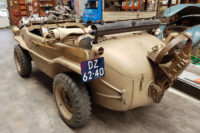
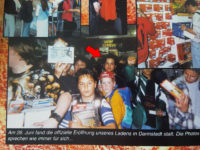
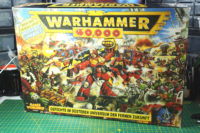
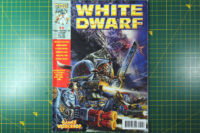

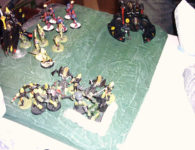
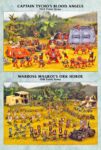
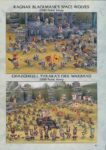
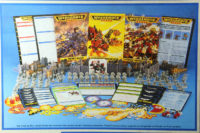
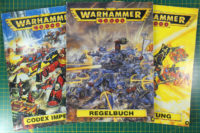
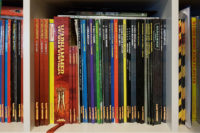












Leave a Reply